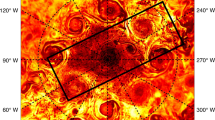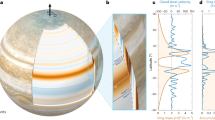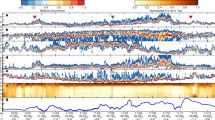Abstract
Many attempts have been made to detect, at the solar photospheric level, large-scale motions related to the Sun's global convection and dynamo (see ref. 1). Because these motions are likely to be influenced by solar rotation, one might expect that they would take the form of ‘bananas’ aligned with the solar rotation axis2, as a result of the Taylor–Proudman constraint. The Paris observatory has one of the longest series of spectroheliograms, dating back to 1919. In view of the current interest in the history of solar activity, we have started to digitize the collection3. This allows us to measure rotational rate and meridional drift for individual sunspots with an accuracy of a few ni s−1 for the best seeing conditions at Meudon. A new phenomenon, which may lead us drastically to revise our ideas on the large-scale convection of the Sun, can immediately be seen. Newly-born sunspots trace a roughly axisymmetric meridional circulation, in the form of four zonal bands, with relatively large velocity amplitude. If these drifts are assumed to trace fluid motions at some level in the solar envelope, the resulting circulation pattern cannot be associated with the ‘banana’ cells mentioned above. We report here results based on two sets of data; one involves a detailed analysis of two periods, each covering five solar rotations while the other is essentially qualitative and results from eye-estimates of the spot meridional drifts over much longer time sequences.
This is a preview of subscription content, access via your institution
Access options
Subscribe to this journal
Receive 51 print issues and online access
$199.00 per year
only $3.90 per issue
Buy this article
- Purchase on Springer Link
- Instant access to full article PDF
Prices may be subject to local taxes which are calculated during checkout
Similar content being viewed by others
References
Schrötcr, E. H. Sol. Phys. 100 (in the press).
Gilman, P. A. in The Sun as a Star (ed. Jordan, St) 231–252 (CNRS, France and NASA, Washington DC, 1981).
Mein, P. & Ribes, E. Astr. and Astrophys. (submitted).
Weiss, N. O. MON. Not. R. astr. Soc. 128, 227 (1964).
Duvall, T. L. Jr & Harvey, J. W. Nature 310, 19–22 (1984).
Duvall, T. L. et al. Nature 310, 22–25 (1984).
Balthazar, H. & Wohl, H. Sol. Phys. 88, 71–75 (1983).
Howard, R., Gilman, P. A. & Gilman, P. I. Astrophys. J. 283, 373–384 (1984).
Gilman, P. A. & Howard, R. Astrophys. J. 283, 385–391 (1984).
Parker, E. N. in Cosmical magnetic fields (eds Marshall, W. & Wilkinson, D. H.) 165 (Oxford University Press, 1979).
Makarov, V. I. Sol. Phys. 93, 393–396 (1984).
Snodgrass, H. B. & Howard, R. Sol. Phys. 95, 221–228 (1985).
MacIntosh, P. S. & Wilson, P. R. Sol. Phys. 97, 59–80 (1985).
Gough, D. in Problems of Stellar Convection (eds Spiegel, E. A. & Zahn, J. P.) 71 (Lecture Note in Phys., Springer, Berlin, 1976).
Author information
Authors and Affiliations
Rights and permissions
About this article
Cite this article
Ribes, E., Mein, P. & Mangeney, A. A large-scale meridional circulation in the convective zone. Nature 318, 170–171 (1985). https://doi.org/10.1038/318170a0
Received:
Accepted:
Issue Date:
DOI: https://doi.org/10.1038/318170a0
This article is cited by
-
Surface and interior meridional circulation in the Sun
Living Reviews in Solar Physics (2022)
-
Solar Magnetic Activity and Total Irradiance Since the Maunder Minimum
Solar Physics (2007)
-
Automated Detection of EUV Prominences
Solar Physics (2006)
-
Study of the distribution of daily fluctuations in observed solar irradiances and other full-disk indices of solar activity
Solar Physics (1996)
Comments
By submitting a comment you agree to abide by our Terms and Community Guidelines. If you find something abusive or that does not comply with our terms or guidelines please flag it as inappropriate.



